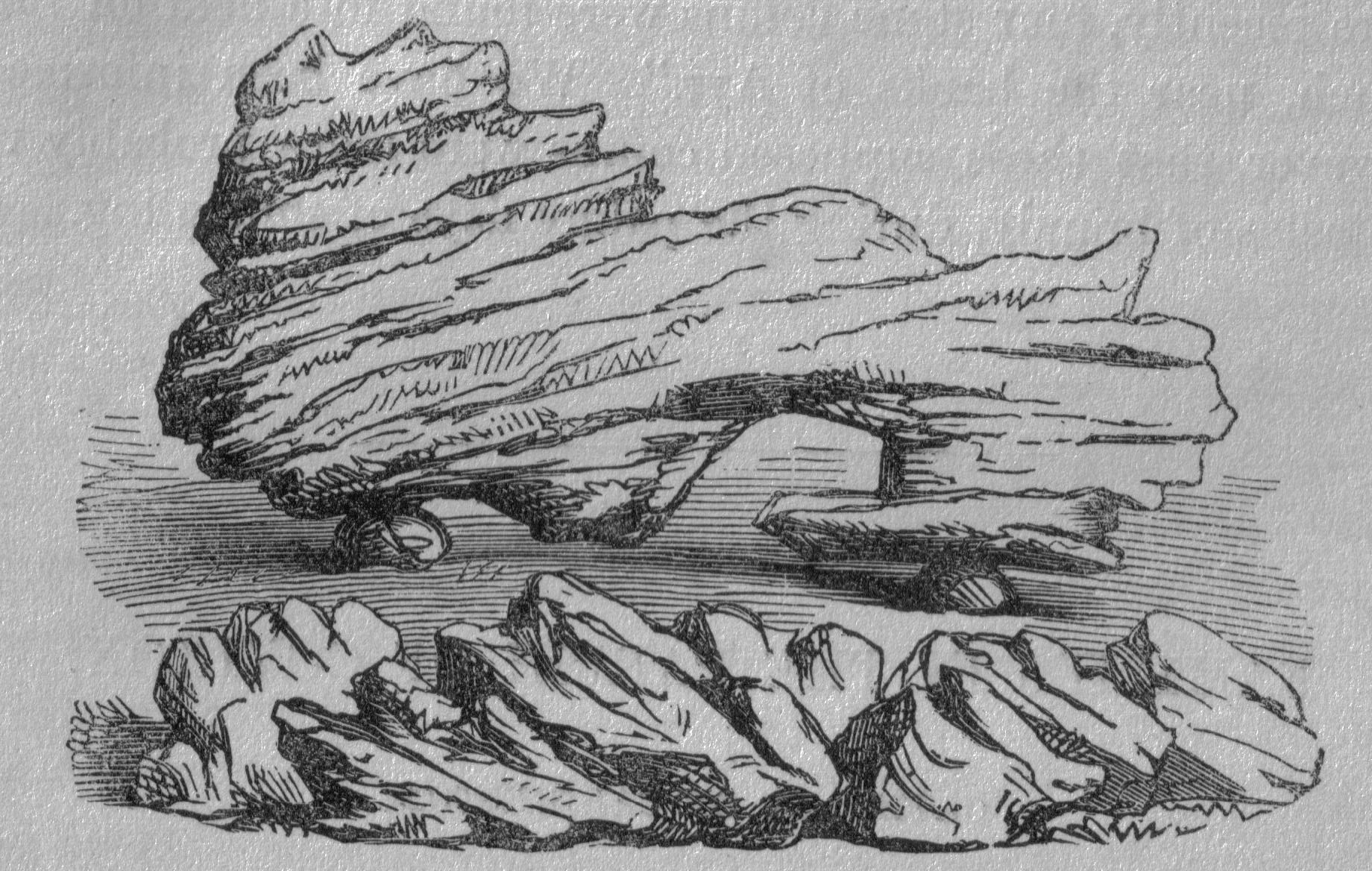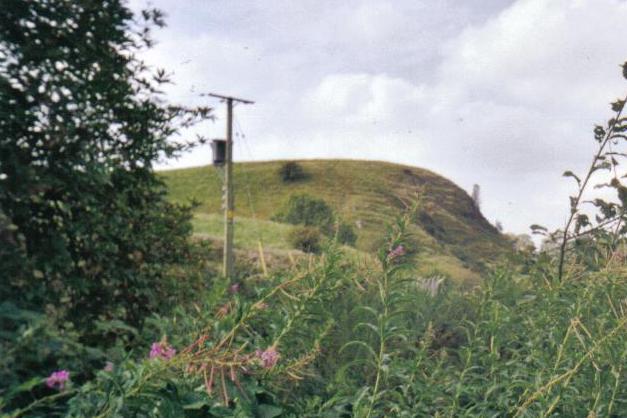|
Thurgartstone
The Thurgartstone or Ogrestone is a prominent glacial erratic stone near Dunlop in East Ayrshire, Scotland. The Thurgartstone stands in a field at Brandleside Farm and is thought to have been a rocking stone at one time, but it no longer moves due to a build up of soil beneath. Name The Thurgartstane is also known as the Ogrestane, the Thorgatstane, the Fiend-Spirit's Stane, T'Ogra Stane, Thugart Stane, Fiend's Stane, Ogart Stane, Ogirtstane, the Ogre's Stone, Horgar Stane, Grit (great) stane or Thougritstane. In modern English, it is the Thurgartstone or Ogrestone. One explanation of the name is that it derives from 'Thor's Great Stone'. Another is that the name comes from the phrase "''Thou Great Stone''" or just '"''grit stane''". The term 'The Stone of the Ogre' may indicate some forgotten legend. Some names may be spelling errors originating in or propagated by the Ordnance Survey or other maps. Another theory is that the name is derived from the word "Tagairtstane", wh ... [...More Info...] [...Related Items...] OR: [Wikipedia] [Google] [Baidu] |
Stones Of Scotland
There are many large stones of Scotland of cultural and historical interest, notably the distinctive Pictish stones, but also the other types discussed below. Stone of Scone The Stone of Scone, (pronounced 'scoon') also commonly known as the "Stone of Destiny" or the "Coronation Stone", is a block of sandstone historically kept at the now-ruined abbey in Scone, near Perth, Scotland. It was used for centuries in the coronation of the monarchs of Scotland, the monarchs of England, and, more recently, British monarchs. Rocking stones Ayrshire apparently is endowed with a geology that lends itself towards the formation of rocking stones. There are several rocking stones, or stones that used to rock at one time, in Ayrshire, Scotland. A rocking stone is recorded from near the site of Saint Bride's Chapel. This stone stands on top of the Craigs of Kyle near Coylton in Ayrshire. It weighs around 30 tons and rest upon two stones. A large standing stone known as Wallace's stone stands ... [...More Info...] [...Related Items...] OR: [Wikipedia] [Google] [Baidu] |
Dunlop, East Ayrshire
Dunlop (; sco, Dunlap, gd, Dùn Lob or gd, Dùn Lùib) is a village and parish in East Ayrshire, Scotland. It lies on the A735, north-east of Stewarton, from Kilmarnock. The road runs on to Lugton and the B706 enters the village from Beith and Burnhouse. History The village The name, first recorded in 1260, may be derived from the Gaelic words ''Dun'' (a castle) and ''Luib'' (a bend). Therefore, it is the fortified hill by the bend in the river. The old local pronunciation was Dulop or Delap without an 'n' and this has led to suggestions of other origins.Paterson, Page 227Dobie, Page 126 In the 1600s, Dunloppe had two fairs a year for the sale of dairy stock, one on the second Friday of May; and the o ...[...More Info...] [...Related Items...] OR: [Wikipedia] [Google] [Baidu] |
Rocking Stone
Rocking stones (also known as logan stones or logans) are large stones that are so finely balanced that the application of just a small force causes them to rock. Typically, rocking stones are residual corestones formed initially by spheroidal weathering and have later been exposed by erosion or glacial erratics left by retreating glaciers.Neuendorf, K.K.E., J.P. Mehl, Jr., and J.A. Jackson, eds. (2005) ''Glossary of Geology'' (5th ed.). Alexandria, Virginia, American Geological Institute. 779 pp. Twidale, C.R., and J.R.V. Romani (2005) ''Landforms and Geology of Granite Terrains.'' A.A. Balkema Publishers Leiden, The Netherlands. 359 pp. Natural rocking stones are found throughout the world. A few rocking stones might be man-made megaliths. Name The word "logan" is probably derived from the word "log", which in an English dialect means to rock. In fact, in some parts of the UK, rocking stones or logan stones are called logging stones. The word "log" might be connected with t ... [...More Info...] [...Related Items...] OR: [Wikipedia] [Google] [Baidu] |
Rocking Stones
Rocking stones (also known as logan stones or logans) are large stones that are so finely balanced that the application of just a small force causes them to rock. Typically, rocking stones are residual corestones formed initially by spheroidal weathering and have later been exposed by erosion or glacial erratics left by retreating glaciers.Neuendorf, K.K.E., J.P. Mehl, Jr., and J.A. Jackson, eds. (2005) ''Glossary of Geology'' (5th ed.). Alexandria, Virginia, American Geological Institute. 779 pp. Twidale, C.R., and J.R.V. Romani (2005) ''Landforms and Geology of Granite Terrains.'' A.A. Balkema Publishers Leiden, The Netherlands. 359 pp. Natural rocking stones are found throughout the world. A few rocking stones might be man-made megaliths. Name The word "logan" is probably derived from the word "log", which in an English dialect means to rock. In fact, in some parts of the UK, rocking stones or logan stones are called logging stones. The word "log" might be connected with t ... [...More Info...] [...Related Items...] OR: [Wikipedia] [Google] [Baidu] |
Chapeltoun
Chapeltoun is an estate on the banks of the Annick Water in East Ayrshire, a rural area of Scotland famous for its milk and cheese production and the Ayrshire or Dunlop breed of cattle. Templeton and the Knights Templar The feudal allocation of tenements to the vassals of the overlord, such as Hugh de Morville, was carried out very carefully, with the boundaries being walked and carefully recorded.Dillon, William J. (1950). The Origins of Feudal Ayrshire. Ayr Arch Nat Hist Soc V.3. p. 73. The term 'ton' at this time was added to the site of the dwelling house, not necessarily a grand stone-built structure, which was bounded by a wall or fence. The tenements were held in a military tenure, the land being in exchange for military assistance to the overlord. In later years the military assistance could be exchanged for financial payment. The name Templeton may have arisen due to lands here being given by the overlord to a vassal. The site of the original dwelling is unknown, La ... [...More Info...] [...Related Items...] OR: [Wikipedia] [Google] [Baidu] |
Carlin Stone
Carlin Stone or Carline Stane is the name given to a number of prehistoric standing stones and natural stone or landscape features in Scotland. The significance of the name is unclear, other than its association with old hags, witches, and the legends of the Cailleach. Etymology A 'Carle' in Scots is a commoner, a husband or in a derogatory sense, a churl or male of low birth. The name 'Carline', 'Cairlin', Carlin, 'Cyarlin', 'Kerlin' or 'Kerl' was also used in lowland Scots as a derogatory term for an old woman meaning an 'old hag'.Scots Dictionary It is from Old Norse ''Kerling'' or a corruption or equivalent in ScotsMcHardy, Stuart (1999), ''Scotland: Myth, Legend & Folklore''. Pub. Luath Press, Edinburgh. P. 24. of the Gaelic word “ |
Buildings And Structures In Scotland
A building, or edifice, is an enclosed structure with a roof and walls standing more or less permanently in one place, such as a house or factory (although there's also portable buildings). Buildings come in a variety of sizes, shapes, and functions, and have been adapted throughout history for a wide number of factors, from building materials available, to weather conditions, land prices, ground conditions, specific uses, prestige, and aesthetic reasons. To better understand the term ''building'' compare the list of nonbuilding structures. Buildings serve several societal needs – primarily as shelter from weather, security, living space, privacy, to store belongings, and to comfortably live and work. A building as a shelter represents a physical division of the human habitat (a place of comfort and safety) and the ''outside'' (a place that at times may be harsh and harmful). Ever since the first cave paintings, buildings have also become objects or canvasses of much artistic ... [...More Info...] [...Related Items...] OR: [Wikipedia] [Google] [Baidu] |
Christianity In Medieval Scotland
Christianity in Medieval Scotland includes all aspects of Christianity in the modern borders of Scotland in the Middle Ages. Christianity was probably introduced to what is now Lowland Scotland by Roman soldiers stationed in the north of the province of Britannia. After the collapse of Roman authority in the fifth century, Christianity is presumed to have survived among the British enclaves in the south of what is now Scotland, but retreated as the pagan Anglo-Saxons advanced. Scotland was largely converted by Irish missions associated with figures such as St Columba, from the fifth to the seventh centuries. These missions founded monastic institutions and collegiate churches that served large areas. Scholars have identified a distinctive form of Celtic Christianity, in which abbots were more significant than bishops, attitudes to clerical celibacy were more relaxed and there were significant differences in practice with Roman Christianity, particularly the form of tonsure and th ... [...More Info...] [...Related Items...] OR: [Wikipedia] [Google] [Baidu] |
Stones
In geology, rock (or stone) is any naturally occurring solid mass or aggregate of minerals or mineraloid matter. It is categorized by the minerals included, its chemical composition, and the way in which it is formed. Rocks form the Earth's outer solid layer, the crust, and most of its interior, except for the liquid outer core and pockets of magma in the asthenosphere. The study of rocks involves multiple subdisciplines of geology, including petrology and mineralogy. It may be limited to rocks found on Earth, or it may include planetary geology that studies the rocks of other celestial objects. Rocks are usually grouped into three main groups: igneous rocks, sedimentary rocks and metamorphic rocks. Igneous rocks are formed when magma cools in the Earth's crust, or lava cools on the ground surface or the seabed. Sedimentary rocks are formed by diagenesis and lithification of sediments, which in turn are formed by the weathering, transport, and deposition of existing rocks. M ... [...More Info...] [...Related Items...] OR: [Wikipedia] [Google] [Baidu] |
James Paterson (journalist)
James Paterson (18 May 1805 – 6 May 1876) was a Scottish journalist on numerous newspapers, writer and antiquary. His works are popular history, rather than scholarly. Life He was the son of James Paterson, farmer at Struthers, Ayrshire, where he was born on 18 May 1805; his father then had money troubles and gave up his farm. Paterson received an education, and then was apprenticed to a printer at the office of the Kilmarnock ''Mirror''. Subsequently he was transferred to the ''Courier'' office in Ayr. On completing his apprenticeship, Paterson went to Glasgow, where he joined the ''Scots Times''. In 1826 he returned to Kilmarnock, took a shop as stationer and printer, and in partnership with other gentlemen started the Kilmarnock ''Chronicle''. Its first number appeared on 4 May 1831, during the agitation for the Great Reform Bill, and the paper closed in May 1832. In 1835 Paterson left Kilmarnock for Dublin, where for some time he acted as correspondent of the Glasgow ''Li ... [...More Info...] [...Related Items...] OR: [Wikipedia] [Google] [Baidu] |
Corsehill
The old Barony and castle of Corsehill lay within the feudal Baillerie of Cunninghame, near Stewarton, now East Ayrshire, Scotland. The Lairds of Corsehill Godfrey de Ross was an early holder of the castle and lands of Corsehill, moving his seat here from the castle at Boarland (also 'Borland') or Dunlop hill. The De Ross family are now represented by the Earls of Glasgow. Andrew Cunningham, second son of William Cunningham, 4th Earl of Glencairn, was the first of the House of Corsehill in 1532. In 1532 his father had granted to him the lands of Doura, Potterton, Little Robertland, and the two Corsehills. In 1538 he was also granted ''Cuttiswray, Clarklands, et Hillhouse.''Paterson, Page 590 He was a great supporter of the reform movement and had his lands forfeited, later returned and died in 1545. Cuthbert Cunningham, son of Andrew, inherited and marrieMatilda 'Maud' Cunningham of Aiket Castle He had two sons, Alexander and Patrick, the latter being involved in the murder ... [...More Info...] [...Related Items...] OR: [Wikipedia] [Google] [Baidu] |








